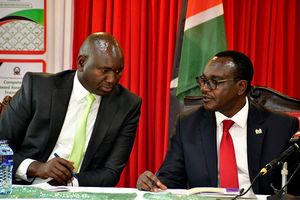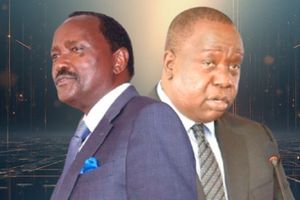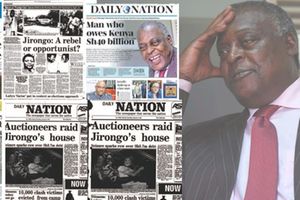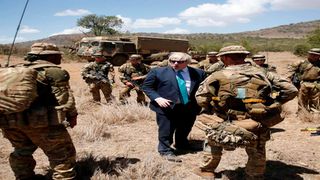
Britain’s Foreign Secretary Boris Johnson (centre) talks to soldiers at the British Training Unit Kenya, popularly known as BATUK, in Ole Naishu, Nanyuki, on March 17, 2017.
| File | Nation Media GroupWeekly Review
Premium
UK-Kenya colonial war games and fresh bid by Parliament to dig up long, secretive history
What you need to know:
- British troops had previously been accused of rape, murder, environmental damage and littering military training fields with unexploded ordnances.
- For the last 60 years, controversy has stalked British troops in Kenya
The unresolved death of Agnes Wanjiru at the hands of a British soldier in March 2012 appears to have given Kenyan politicians a chance to look at the British Army’s activities in the country.
Whichever way the inquiry into the conduct of the training units in Nanyuki goes, the long history of impunity and secrecy of the military pact could be of interest.
Before Wanjiru’s murder became public, British troops had previously been accused of rape, murder, environmental damage and littering military training fields with unexploded ordnances. At best, when cornered by lawyers, they opted for out-of-court settlements and paid compensation to victims, and, at worst, they displayed impunity.
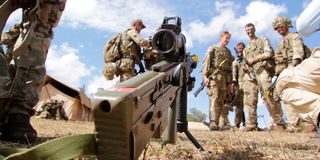
British Army soldiers during a training exercise in Lolldaiga, Laikipia County. on November 14, 2022.
And now, as the National Assembly’s Defence, Intelligence and Foreign Relations Committee prepares to investigate British Army activities in Laikipia, Isiolo, and Samburu military fields, one question remains: how much they can dig up, given the long history and secrecy involved.
For the last 60 years, controversy has stalked British troops in Kenya. Initially, they had wanted a permanent military base, but this was downgraded to training. It is this history that the parliamentary committee will look at as it tries to unravel the genesis of British troops’ impunity in Kenya.
Air force base
Records indicate that in the late 1950s, the British had decided to build an army base in Kahawa, hoping to station their troops there after independence. More so, they were planning naval and air force bases. This became a contentious issue and in November 1961, the African members at the then Legislative Council (LegCo) moved a motion asking Britain to stop the construction.
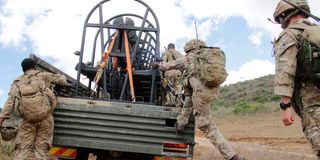
British Army soldiers board a military truck after a battle group exercise during a media engagement at the Lolldaiga training area in Laikipia County on November 14, 2022.
At the time, Britain viewed Kenya as a strategic colony where it would retain military bases for its defence policy and programmes. Tom Mboya, one of the negotiators for Kenya’s Constitution, told the LegCo that “an independent Kenya shall remain positively independent, positively neutral” from global power struggles. “We do not want Kenya to become the football ground on which the East and West come to play their game outside their territories,” said Mboya.
It was Mboya who set the tone for the downgrading of British army bases to training units. The bone of contention was the £3.6 million expansion of Templer Barracks in Kahawa. Built between 1959 and 1962, the barracks housed two battalions and were said to be among the most expensive British bases overseas. Though Britain had agreed to scale down the project, Mboya argued that “even if the base was on one acre of the soil of this country, …we would not be in a position to have full sovereignty over the breadth and width of our country…it would be an attraction to those who would seek to destroy our country’s independence”.
Interestingly, Kahawa did not survive as a British military barracks, and most buildings were handed over to form what is today Kenyatta University.
British bases
Another opponent of the British bases was Argwings-Kodhek, the first African lawyer. “The British are not being philanthropic at all in putting these bases here so that we shall have employment at Kiambu, or that we shall have some people who will be able to bath correctly at the coast of Mombasa…our job at the moment is to try by all means to get rid of all forms of vestiges of colonialism,” he argued.
The other fear was that the British troops would use such bases to crush nationalist revolts in their remaining colonies. The Mboya motion was passed on November 30, 1961, and stated that the “future of the British bases in Kenya will be the subject of negotiation between the Kenya Government and the Government of the United Kingdom”.
After independence in December, 1963, it was agreed that the British hand over the Templer Barracks to Kenya by 1965. But as the British finalised the handing over of the barracks to Jomo Kenyatta – set for September 17, 1965, when the Kenyatta College was to open – a January 1964 mutiny within Lanet Barracks made Jomo Kenyatta rethink the removal of the British troops. On that day, the 11th Battalion soldiers broke into the armoury and demanded to meet Kenyatta, then the Prime Minister.
The British forces in Kenya quickly quelled the mutiny, with the 3rd Regiment of the Royal Horse Artillery securing strategic areas in Nairobi, while others ring-fenced the Lanet Barracks. It appeared to be an indication that the independent Kenyan state would require the British troops for protection.
As Kenyatta’s Vice-President, Oginga Odinga, would later say, Kenyatta “seemed not to recover from the shock of the army mutiny and ... seemed to be plagued by a fear that the government was not safe from internal revolution”.
It was during this period – on June 3, 1964 – that a Memorandum of Intention and Understanding was signed by Kenyatta and the British High Commissioner, Geoffrey de Freitas, giving Britain some say in Kenya’s military, and its non-negotiable demand: that twice year, the British would be training in Kenya.
Elite soldiers
As a result of that MOU, British troops would play a crucial role in the kind of military that emerged in Kenya as they trained many elite soldiers. More so, they recommended the creation of the Chief of Defence Staff position. Kenyatta is said to have requested that this position go to a British officer, Maj Gen Bernard Penfold. He also appointed Brigadier Joseph Ndolo as Commander of the army.
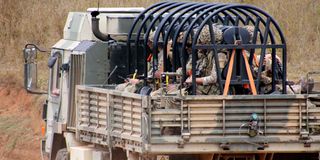
British Army soldiers board a military truck after a battle group exercise during a media engagement at the Lolldaiga training area in Laikipia County on November 14, 2022.
With all that, Kenyatta felt secure since, under the MOU, Britain agreed to “make available (its) troops stationed in Kenya to assist (his) government in dealing with internal disturbances”. By default, Kenya had chosen a military ally. More so, historians argue that with the clause that obligated the British to protect the Kenyatta government if their troops were in Kenya, the British soldiers, in some kind of reverse psychology, also ensured that apart from the time they were in training they had no other troops in Kenya.
Kenyatta’s next scare came from the Somali government, which threatened to annex part of north-eastern Kenya by supporting a secession. This fear saw Kenya negotiate what historians call the ‘Bamburi Understanding’, which was verbally agreed upon in 1966.
It was controversial since the British had what was known as the ‘Sandys Understanding’: “There were clear differences between the British and Kenyan interpretations of what (Commonwealth Secretary Duncan) Sandys had said,” argues historian Poppy Cullen. In their understanding, Kenyan officials “assumed that British ground attack aircraft would be available to support the Kenya Army within 24 hours and that limited ground forces would start arriving within 48 hours of Somali regular forces violating our frontier”.
Only a few people in the Kenyatta cabinet knew that there was no clarity in the Bamburi Understanding. These included President Kenyatta, Attorney-General Charles Njonjo, Agriculture Minister Bruce Mackenzie and Defence Minister Dr Njoroge Mungai, and they openly pushed the British High Commission to craft a formal paper.
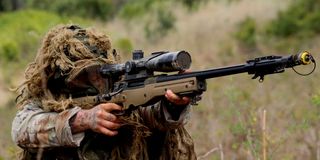
A sniper from the British Army Training Unit in Kenya displays his skills at the Lolldaiga training area in Laikipia County on November 14, 2022.
A final paper was handed over to Kenyatta on January 25, 1967, and one sentence read: “Kenya government may be sure that if Kenya were the victim of outright aggression by Somalia, the British government would give the situation most urgent consideration.”
This is the military relationship and support from the British that President Daniel arap Moi inherited. Moi was close to British Prime Minister Margaret Thatcher. But while the military expanded, it was the Americans who would be of more use to Moi than Britain. In return, Moi gave the US a military base at the Kenyan coast. Still, Thatcher agreed to Moi’s request for a grant to repay British loans for military expenditure. Thatcher wanted Moi to support British Africa policy over Rhodesia (now Zimbabwe).
The pact expired during the reign of President Mwai Kibaki, who was initially reluctant to renew it due to the hostility that his government experienced from London.
These agreements have always informed the British troops’ presence in Kenya. But they have also led to controversies. In 2001, the British law firm of Martin Day secured a total of KSh450 million compensation to Kenyan pastoralists who had been maimed or killed by unexploded ordnances.
The UK refused to pay some of the claims on the basis that the incidents happened too long ago. At Archers Post, the British are now evading payments by arguing that the fields are used by Kenyans too.
Besides the case of Wanjiru, the British Army Training Unit-Kenya is facing criticism from 6,000 residents of Loldaiga in Laikipia North who were affected by a wildfire triggered by military activities. All eyes will be on the parliament team to see how much dirt it can unearth.
[email protected] @johnkamau1


